Caribbean Explorer II, Saba, BESContents of this Issue: Caribbean Explorer II, Saba, BES Your Trip Reports Are Important Common Sunscreens Can Damage Marine Life (and You Too) We Asked: Do You Download Your Dives? Keeping An Important Discovery Secret Diving Accident Stats are "Inaccurate ... Manipulated ... Misrepresented" Never Forget: Let Your BC Find the Surface U.S. Dive Magazine's Best Diving Destinations Before the Internet, You Called Bob Goddess to Go Diving Don't Be Reluctant to Use Air: It's What We Did When That's All We Had The Perils of Travel Remain in the Time of COVID An Important Advance for Closed-Circuit Divers PADI Responds to Cancun Diver Fatalities Editorial Office: Ben Davison Publisher and Editor Undercurrent 3020 Bridgeway, Suite 102 Sausalito, CA 94965 fine diving marred only by trolls aboard from the August, 2022 issue of Undercurrent
Dear Fellow Diver: Before COVID, my trips on the Caribbean Explorer II began in Sint Maarten and ended in Saint Kitts (or the reverse), with the diving split between Saba and Saint Kitts/Nevis. On my April trip, because of COVID restrictions on St. Kitts, the Explorer II restricted all diving to Saba (and will until at least September). Thanks to Saba's status as a marine park, Saba's reefs are healthier and more beautiful than Saint Kitts's (though diving Saint Kitts can be quite pleasant). But Saba is also windier and rougher, and the dives are deeper.
Almost everyone on the boat remarked on how cold the air conditioning was in the cabins, something I remembered from my previous trips, so I taped over my vent. (Note to owner Clay McCardell: please fine-tune the air conditioning, save money, and let us sleep without three blankets and heavy socks!) The salon and sun deck were not air-conditioned, and many of us hung out there to enjoy the mid-80s temperatures and avoid the cabins' Arctic chill and cramped conditions. The sun deck also served as the informal cocktail gathering site, complete with sunset views. Most of us hung out here between dives, reading, snoozing, or watching stuff on our devices. By 9:30 P.M., most of us had collapsed in bed, tired from a lot of diving. Normally, the boat departs Sint Maarten on Saturday evening to undertake the 3-4 hour crossing to Saba, but we had wind and rough seas, so we departed on Sunday morning. It was safer than a potentially dangerous night passage, but we lost two dives. And it still was rough! I always take Bonine (or meclizine), an over-the-counter medication for motion sickness, beginning a couple of days before boarding, and I needed it the entire trip. Our first dive began at 3:30 PM at Torrens Point, a series of large coral heads and boulders, and not deep, so it was a good spot to adjust weights or try new gear. I navigated with my compass since it lacks distinctive features that make natural navigation easy. We dived Torrens Point four times on this trip. Its many massive boulders -- the ejecta of Saba's volcanic past -- are home to lots of critters. Captain Sarah led us on a wonderful dive one day when conditions were uncharacteristically calm. She guided us to a swim-thru next to the island. I slowly swam through the arch on the surface on my back, enjoying the sunlight and dramatic architecture of the rocks. She pointed out chitons, living fossils, on the rocky walls. As we navigated back to the boat amidst the boulders, schools of blue tangs (I call them tang bangs) descended on the rocks to eat algae. Lots of lobsters scuttled in rocky holes. A pair of small nurse sharks competed for food wedged in a hole, while a yellowfin grouper lurked nearby to snap up anything the sharks flushed out. Creole wrasses engaged in frenzied mating. It was a delightful dive. Now here's the downside of Saba: this tiny island, which looks like a kid's drawing of a volcano rising alone from the sea, is entirely exposed, so it's rough, windy, and subject to quickly changing currents. With just a few moorings robust enough to hold the Explorer, only a couple are safe for night mooring. The most commonly used was at Customs House Reef, which is not a good spot for night diving. The top of the reef starts at about 70 feet, and it's a somewhat dull dive. You can kick around the reef in either direction, but it's not very pretty or distinctive. Nor does it make a good night dive site: too deep, too unvaried. The dive deck is big and functional, with a large camera table, charging area, and two deck showers with warm water. One enters the water from the dive deck with a giant stride, dropping about 4-5 feet. Typically, dives were at 8:15, 11:00, 2:15, 4:45, and 7:30. Breakfast was served before the first dive, with snacks, lunch, and dinner following the others. The crew greeted night divers with hot chocolate (with a dollop of booze if one liked) as they emerged from the water, along with a hot towel. And don't forget your rubber: water temps ranged from 74-79F. I always wore a 7mm and hooded vest, and brought my Thermalution heated shirt, which I loaned to one shivering diver when I was not wearing it. Three of the divers on the boat were Canadian, and even they were chilled!
Which was why it was so annoying that two of the 14 divers insisted nonetheless on hanging onto the ladder while removing their fins. Both of these divers were experienced, and why they didn't understand why the captain insisted on everyone removing fins on the dinghy line was beyond me. And everyone else. Unpleasant words passed between these divers and Captain Sarah, whose affable character belies her knowledge of her job, as well as the dive deck crew -- Demian, Mackenzie, and John. But the two divers absolutely refused to comply. Luckily, neither were hurt, but it dampened the trip as these two miscreants sulked and complained. More later about why this mattered. Of course, diving makes you hungry, and the food was as good as on my previous two trips. The usual chef, Julian, was on holiday, but his replacement, Jonathan, fed us nobly. Mornings began with eggs cooked to order, pancakes, waffles, or French toast; bacon or sausage, and once, a frittata with cheese and veggies. After the morning dive, Jonathan offered a sweet treat, like freshly baked cookies or lemon cake. After the afternoon dive, he produced savory treats like jalapeno poppers, egg rolls, and quesadillas. Lunches included veggie-or-hamburgers, lasagna, braised beef, and chicken salad; fresh hot soup and salad were always available. Dinners spoiled us. Chicken tarragon, shrimp frá Diavolo, ribs and chicken barbeque, pork tenderloin, steak, and a huge variety of vegetables and salad. There was always dessert, from tiramisu to crème brulée. Snacks, mostly packaged cookies and chips, were always available. The vegetarians on board seemed very happy with the special dishes made for them.
For me, the best Saba dive is Diamond Rock, an exposed seamount. Like most seamounts, Diamond Rock is like the only bar in a dry county, attracting lots of fish. After entering the water, I followed divemaster Mack to the rock and began a counter-clockwise circumnavigation at 75 feet. The steep walls were encrusted with corals and sponges. Big yellowfin grouper cast us baleful glances while queen triggerfish swam by. A small nurse shark lurked in the sand while a big green turtle cruised nearby. As we rounded the back of the rock, the current picked up. A lot. I stayed low to the rocks, gently holding on to bare rocks since our only choice was to swim against the current. But some less experienced divers remained in the water column, kicking for dear life and sucking down gas. By the time our group returned to the starting point, one diver was out of gas and had to share with his buddy. In his anxiety, he exhausted his buddy's tank too, so my buddy and I shared with both of them. Luckily, we caught Mack's eye, who had plenty of air, and escorted the two back to the boat. I was glad of my training in sharing air and rescues, but nonetheless, I boarded with a nearly empty tank. Many moorings around Saba can only bear the strain of a dayboat, so the Caribbean Explorer II covers these sites with a live drop and pickup -- but divers must comply with the protocol of hanging onto the dinghy line and removing fins there before climbing the ladder. Because the captain wanted to get everyone in the water, the two divers who adamantly refused to comply with this protocol prevented us from Shark Shoals or other dayboat sites. These two really pissed me off. Not only was their undercurrent of tension uncomfortable, but also these two malcontents made it impossible for 12 other divers to enjoy new sites. I was on my 75th liveaboard trip, and I've never witnessed that kind of diver mutiny. I resented it.
At first, I was disappointed that COVID restrictions limited this trip to Saba. But as I dived the same sites several times on Saba, I realized how much pleasure I took in seeing the many moods alter with the conditions -- both familiar and changing. And though no one would say the Caribbean Explorer II is a luxury liveaboard, the food is good and the crew excellent. I see a fourth trip on this boat in my future. --A.E.L. Author's Bio: Our writer, a retired university professor, has written for Undercurrent for almost 20 years. An experienced diver (over 3700 logged dives), A.E.L. has dived all over the warm-water world.
|

I want to get all the stories! Tell me how I can become an Undercurrent Online Member and get online access to all the articles of Undercurrent as well as thousands of first hand reports on dive operations world-wide
| Home | Online Members Area | My Account |
Login
|
Join
|
| Travel Index |
Dive Resort & Liveaboard Reviews
|
Featured Reports
|
Recent
Issues
|
Back Issues
|
|
Dive Gear
Index
|
Health/Safety Index
|
Environment & Misc.
Index
|
Seasonal Planner
|
Blogs
|
Free Articles
|
Book Picks
|
News
|
|
Special Offers
|
RSS
|
FAQ
|
About Us
|
Contact Us
|
Links
|
3020 Bridgeway, Ste 102, Sausalito, Ca 94965
All rights reserved.

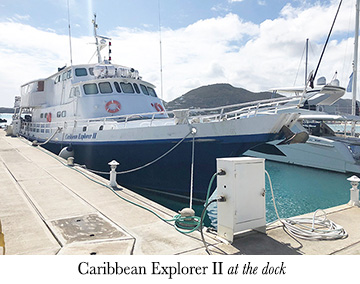 The Caribbean Explorer II is older than many liveaboards and somewhat cramped at 115 feet and nine cabins. My cabin, which I booked as a solo, featured a double bed so short that I needed to sleep diagonally so my feet didn't bump up against the hull -- and I'm 5'9" tall. But to be fair, a trip on this boat costs much less than on other more expensive Explorer vessels or other Caribbean liveaboards.
The Caribbean Explorer II is older than many liveaboards and somewhat cramped at 115 feet and nine cabins. My cabin, which I booked as a solo, featured a double bed so short that I needed to sleep diagonally so my feet didn't bump up against the hull -- and I'm 5'9" tall. But to be fair, a trip on this boat costs much less than on other more expensive Explorer vessels or other Caribbean liveaboards.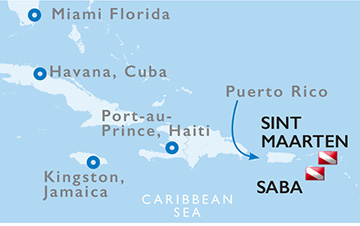 Getting back onto the boat can be tricky. The swim platform is large and heavy. As the boat rises and falls on the swells, the platform creates a powerful suction that could easily pull a diver off the ladder and under the transom. To avoid crushed skulls, divers were instructed to ascend to the dinghy line, take off their fins while holding the line, pull themselves to the platform, hand up their fins, and then stand on the ladder, hold tight, and climb up. If one were to hang onto the ladder while removing fins as the platform went up and down, it would be easy to lose footing and get sucked under it. It's not an easy way to get back onto a boat, but given the physics of cavitation, it is much safer and sensible.
Getting back onto the boat can be tricky. The swim platform is large and heavy. As the boat rises and falls on the swells, the platform creates a powerful suction that could easily pull a diver off the ladder and under the transom. To avoid crushed skulls, divers were instructed to ascend to the dinghy line, take off their fins while holding the line, pull themselves to the platform, hand up their fins, and then stand on the ladder, hold tight, and climb up. If one were to hang onto the ladder while removing fins as the platform went up and down, it would be easy to lose footing and get sucked under it. It's not an easy way to get back onto a boat, but given the physics of cavitation, it is much safer and sensible.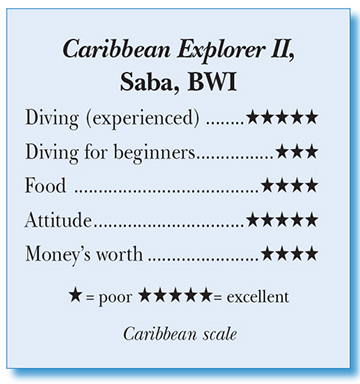 Briefings before each dive took advantage of digital technology, with careful renderings of each dive site. I liked these digital renderings more than the typical whiteboard drawings because they were accurate, included compass points, and had a fun touch: Captain Sarah hid a chicken in the design of each map!
Briefings before each dive took advantage of digital technology, with careful renderings of each dive site. I liked these digital renderings more than the typical whiteboard drawings because they were accurate, included compass points, and had a fun touch: Captain Sarah hid a chicken in the design of each map! 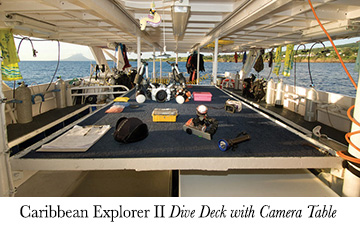 Because the itinerary remained around Saba, we dived Tent Reef six times. For me, it's a blast thanks to its variety of turtle grass, deeper reef, shallow reef, and a promenade parallel to the shore of a mini-wall and boulders with swim-thrus. Changing currents mean robust sponges, often vivid yellow. Turtles abound, both green and hawksbills. My buddy and I had fun tooling around this easily navigated site, sniffing out little stuff like a juvenile jackknife fish, and gently cruising through the swim-thrus among the big boulders. The shallow shelf allows for delightful safety stops at 15 feet, where we swayed to the surge and watched lots of turtles nibble and cruise. The sparkling sunlight in the shallows added to the beauty.
Because the itinerary remained around Saba, we dived Tent Reef six times. For me, it's a blast thanks to its variety of turtle grass, deeper reef, shallow reef, and a promenade parallel to the shore of a mini-wall and boulders with swim-thrus. Changing currents mean robust sponges, often vivid yellow. Turtles abound, both green and hawksbills. My buddy and I had fun tooling around this easily navigated site, sniffing out little stuff like a juvenile jackknife fish, and gently cruising through the swim-thrus among the big boulders. The shallow shelf allows for delightful safety stops at 15 feet, where we swayed to the surge and watched lots of turtles nibble and cruise. The sparkling sunlight in the shallows added to the beauty.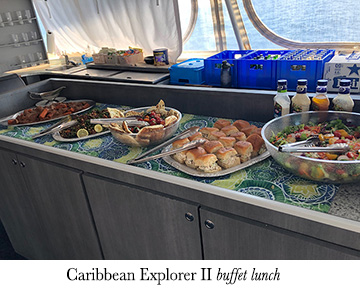 Tent Wall is adjacent to Tent Reef, and I was delighted to dive it three times. It starts at 60 feet and drops into the abyss. I prefer staying near the top of walls to enjoy more light and dive time, but I kicked over the wall into the intriguing semi-gloom. Gray reef sharks cruised by several times as I contemplated the deep blue vista. It was terrific scenery dive, as is Saba's premier wall, Tedran Wall (named for Sea Saba DMs, Ted and Randy). It's a deep dive, with the top of the wall in 70m feet of water and its face studded with large, craggy deep-water gorgonians jutting from the wall. We saw stingrays at the top of the wall and rainbow runners and gray reef sharks cruising off the wall. The stark beauty was enhanced by the moaning of humpbacks in the distance!
Tent Wall is adjacent to Tent Reef, and I was delighted to dive it three times. It starts at 60 feet and drops into the abyss. I prefer staying near the top of walls to enjoy more light and dive time, but I kicked over the wall into the intriguing semi-gloom. Gray reef sharks cruised by several times as I contemplated the deep blue vista. It was terrific scenery dive, as is Saba's premier wall, Tedran Wall (named for Sea Saba DMs, Ted and Randy). It's a deep dive, with the top of the wall in 70m feet of water and its face studded with large, craggy deep-water gorgonians jutting from the wall. We saw stingrays at the top of the wall and rainbow runners and gray reef sharks cruising off the wall. The stark beauty was enhanced by the moaning of humpbacks in the distance! Divers Compass: Sint Maartin (SXM) is served by American, JetBlue, Delta, and United, as well as several European airlines . . . A week on the CExII retails for $2395, with a 65 percent single supplement; they often run promotions as well (I got $500 off) . . . All alcohol was included, with the usual proviso that your first drink signaled your last dive . . . Several divers used this trip to get Nitrox certified. . .
Divers Compass: Sint Maartin (SXM) is served by American, JetBlue, Delta, and United, as well as several European airlines . . . A week on the CExII retails for $2395, with a 65 percent single supplement; they often run promotions as well (I got $500 off) . . . All alcohol was included, with the usual proviso that your first drink signaled your last dive . . . Several divers used this trip to get Nitrox certified. . . 